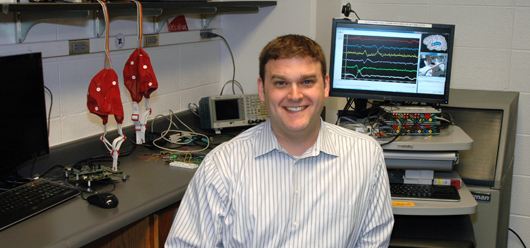
Three years after the historic feat, Research Fellow Adam Wilson, PhD, is still known as the man who sent the “tweet heard round the world.”
The message itself wasn’t earth-shattering — “USING EEG TO SEND TWEET” – but the method was as revolutionary as the first telephone call and the first e-mail. Dr. Wilson composed the tweet by concentrating on individual letters flashing before him on a computer screen while wearing a tight-fitting cap that was embedded with electrodes and hooked up to a computer and an electroencephalograph. In short, he created the message simply by thinking it.The technology, known as Brain-Computer Interface, or BCI, has continued to evolve since then. And Dr. Wilson, who works in the University of Cincinnati (UC) Department of Neurosurgery, foresees a not-too-distant time when people with profound disabilities will be using BCI to communicate. “I think BCI technology has the ability to be a transformative and enabling technology for people who have severe neuromuscular disorders such as ALS (Lou Gehrig’s disease), paralysis, and locked-in syndrome,” Dr. Wilson said.
Locked-in syndrome was illustrated by the book and movie, The Diving Bell and the Butterfly, which told the story of a French magazine editor who was left almost completely paralyzed, but with all of his mental faculties, after suffering a massive stroke. He communicated one letter at a time by raising an eyebrow when a nurse, moving through the alphabet, stated the letter that he wanted to use. “For someone who has locked-in syndrome and has no other means of communication, BCI is going to be a tremendous, life-changing tool,” Dr. Wilson said.
Dr. Wilson will be the keynote speaker at a BCI Workshop & Hands-on Seminar, presented jointly with the UC College of Engineering & Applied Science and g.tec Medical Engineering, of Graz, Austria, from 9 a.m. to 4 p.m. Monday, May 21, at Tangeman University Center on the UC campus. The free event is targeted to people who wish to learn BCI skills or who wish to integrate BCI technology into their area of expertise.
And on June 2, Dr. Wilson will make a presentation about BCI to children attending the “Cool Jobs” event at the World Science Festival in New York City. After actor Alan Alda warms up the show, Dr. Wilson hopes to pique the children’s interest in science and technology by having two students play “pong” with brain activity while wearing EEG caps. “Each person will control a paddle by thinking about moving their hands or moving their feet,” Dr. Wilson said. “Another person will be up there sending tweets during the presentation.”
If children are playing pong with their brains today, additional applications – including video games – are sure to be here tomorrow. “I think the technology is getting reliable and cheap enough that it’s going to be in the home within the next decade,” Dr. Wilson said. “We’ll be able to set someone up so that they can use it pretty consistently. It will enable at-home diagnostics that you currently have to do at a hospital, such as detecting epilepsy or seizures, or it may allow us to detect or reduce stress through biofeedback. It may be used to detect ADHD. And there will be gaming and military applications as well.”
Military applications could appear as a robotic exoskeleton in which a soldier uses his or her brain to control a robotic arm or hand or to manipulate a drone-like aircraft system. It could also potentially be used in criminal cases or intelligence gathering. “If you’re waiting for a particular image or letter or response and your brain finally sees it, it goes “woooop,” Dr. Wilson said with a laugh, making a tall “J” with his index finger and laughing. “You have no control over that. My guess is you could use this as a kind of lie detector test. What’s your name, where do you live, did you murder this person? You have no way of controlling your response to it. I don’t know if it’s a good idea to go down this route or not, but people are certainly considering it.”
Although many consider Twitter to be a mindless haven for talking without thinking, Mr. Wilson thinks it is an ideal format for mindful talking just by thinking. “Twitter is nice because it forces you to be succinct and to the point with what you’re trying to say,” he said. Indeed, his famous USING EEG TO SEND TWEET took four minutes to compose.
Dr. Wilson, who earned his doctorate in biomedical engineering from the University of Wisconsin, has contributed extensively to the software suite BCI2000, which is used by more than 400 labs worldwide. His dissertation included work with implantable electrode systems called electrocorticograms (ECoG), which provide neural signals that are superior to those he used in his famous tweet.
In 2009 Dr. Wilson joined the Department of Neurosurgery to collaborate with Assistant Professor Jed Hartings, PhD, an expert in the pathologic brain waves (spreading depolarizations) that occur after stroke or brain trauma. Drs. Hartings and Wilson are creating a system for processing and analyzing the enormous amounts of data that their studies are producing.
The software that produced “Tweeting by Thinking” was named the 9th best invention of 2009 by Time magazine, and Dr. Wilson was named one of Popular Science magazine’s “Brilliant 10 Class of 2009.” And the legendary tweet — with more than 278,000 followers – lives on @uwbci.
— Cindy Starr
